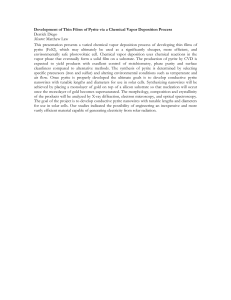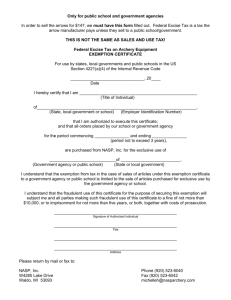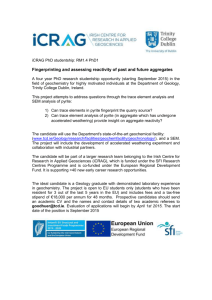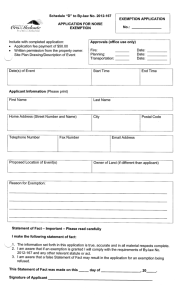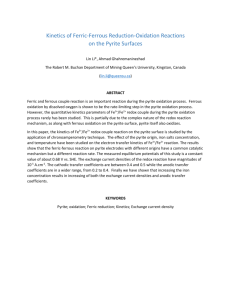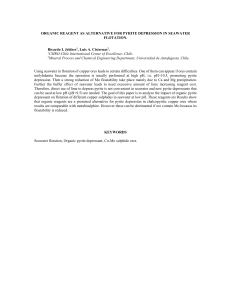Section 10A- Guidelines on the operation of the Local Property Tax
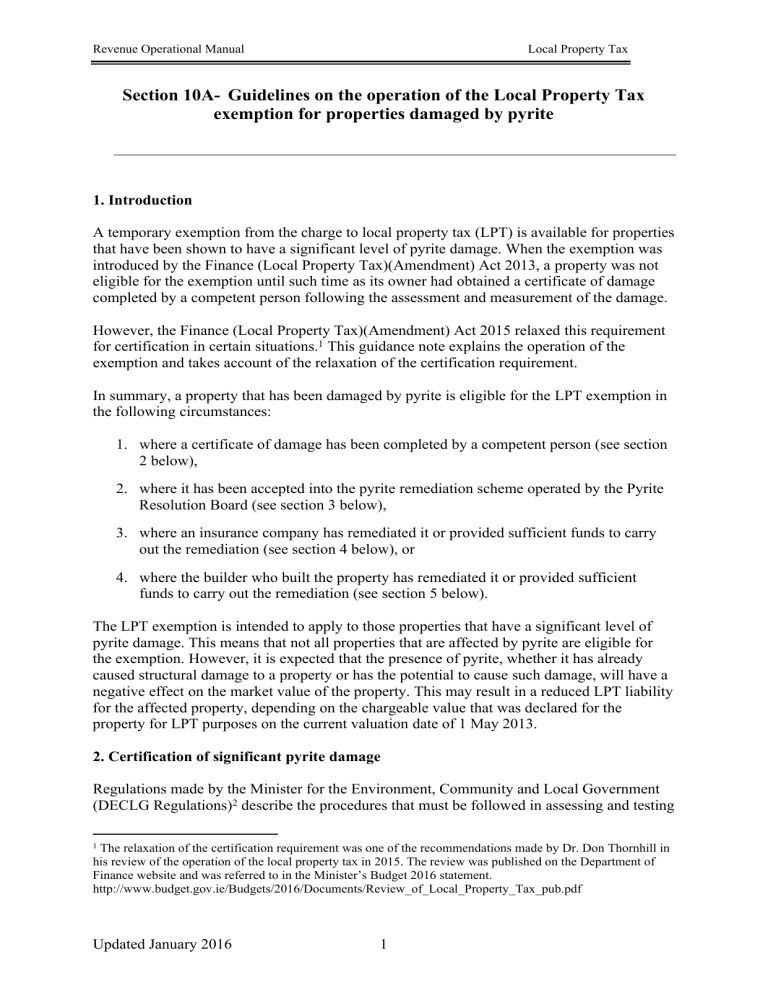
Revenue Operational Manual Local Property Tax
Section 10AGuidelines on the operation of the Local Property Tax exemption for properties damaged by pyrite
1. Introduction
A temporary exemption from the charge to local property tax (LPT) is available for properties that have been shown to have a significant level of pyrite damage. When the exemption was introduced by the Finance (Local Property Tax)(Amendment) Act 2013, a property was not eligible for the exemption until such time as its owner had obtained a certificate of damage completed by a competent person following the assessment and measurement of the damage.
However, the Finance (Local Property Tax)(Amendment) Act 2015 relaxed this requirement for certification in certain situations.
1 This guidance note explains the operation of the exemption and takes account of the relaxation of the certification requirement.
In summary, a property that has been damaged by pyrite is eligible for the LPT exemption in the following circumstances:
1. where a certificate of damage has been completed by a competent person (see section
2 below),
2. where it has been accepted into the pyrite remediation scheme operated by the Pyrite
Resolution Board (see section 3 below),
3. where an insurance company has remediated it or provided sufficient funds to carry out the remediation (see section 4 below), or
4. where the builder who built the property has remediated it or provided sufficient funds to carry out the remediation (see section 5 below).
The LPT exemption is intended to apply to those properties that have a significant level of pyrite damage. This means that not all properties that are affected by pyrite are eligible for the exemption. However, it is expected that the presence of pyrite, whether it has already caused structural damage to a property or has the potential to cause such damage, will have a negative effect on the market value of the property. This may result in a reduced LPT liability for the affected property, depending on the chargeable value that was declared for the property for LPT purposes on the current valuation date of 1 May 2013.
2. Certification of significant pyrite damage
Regulations made by the Minister for the Environment, Community and Local Government
(DECLG Regulations) 2 describe the procedures that must be followed in assessing and testing
1 The relaxation of the certification requirement was one of the recommendations made by Dr. Don Thornhill in his review of the operation of the local property tax in 2015. The review was published on the Department of
Finance website and was referred to in the Minister’s Budget 2016 statement. http://www.budget.gov.ie/Budgets/2016/Documents/Review_of_Local_Property_Tax_pub.pdf
Updated January 2016 1
Revenue Operational Manual Local Property Tax a property for pyrite damage and in certifying the level of damage. The DECLG Regulations are based on procedures described in an Irish Standard published by the National Standards
Authority of Ireland: I.S. 398.
3 These procedures are very technical and require the involvement of engineers, geologists and other competent persons. Their end result is the certification of the risk posed by the presence of pyrite or the level of actual pyrite damage, depending on the particular circumstances. This is the certificate required by Revenue as evidence of eligibility for the LPT exemption.
The certificate must confirm that a property has ‘significant pyritic damage’, i.e. Category D on the certificate. The I.S. 398 procedures are summarised at Appendix A of these guidelines by way of providing some background information to how the required certificate of damage is to be obtained. For illustration purposes, this certificate (contained in I.S. 398) is reproduced in Appendix B of these guidelines.
A property that was tested prior to the publication of the DECLG Regulations is also eligible for the LPT exemption where the testing results based on the sampling of the sub-floor hardcore material from the property are validated by a competent person as being in accordance with, or equivalent to, I.S. 398. A different certificate is used in these circumstances and is included in Appendix C of these guidelines.
Properties that were damaged by pyrite but remediated before the DECLG Regulations came into effect on 2 May 2013 are not eligible for the LPT exemption. However, where a property qualifies for the exemption following the completion of the relevant certificate, the property continues to be eligible for the exemption even where it is subsequently remediated before the end of the exemption period.
Revenue has no responsibility in relation to the DECLG Regulations. Any questions on the
Regulations should be addressed to pyriteinformation@environ.ie. The main DECLG telephone number is 01-8882000.
3.
Remediation of properties by the Pyrite Remediation Board
Since February 2014, the Pyrite Resolution Board (PRB), with support from the Housing
Agency, has operated a programme of remediation works for residential properties that have been damaged to a significant extent by pyrite.
4 A property owner who applies to the PRB to be included in the pyrite remediation scheme must submit a Building Condition Assessment
(BCA) report prepared by a competent person such as an engineer. Subject to the application being validated by the PRB, any follow-up testing of the sub-floor hardcore material required to confirm that the damage recorded in the BCA is attributable to pyrite is undertaken under the scheme by the Housing Agency. However, the Housing agency may not carry out testing on each and every property.
Where a property is accepted into the pyrite remediation scheme without testing, the certificate of pyrite damage as required by Revenue under the DECLG Regulations will
3
2 The Finance (Local Property Tax) (Pyrite Exemption) Regulations 2013 ( S.I. 147/2013) came into effect on 2
May 2013.
I.S. 398-1:2013 Reactive pyrite in sub-floor hardcore material – Part 1: Testing and categorisation protocol”.
I.S. 398 is available only by purchase from the NSAI at a cost of €60. In the event that this standard is revised by the NSAI, the references in this guidance note should be read as references to the revised version of the standard.
4 Information about the remediation scheme is available at www.pyriteboard.ie
.
Updated January 2016 2
Revenue Operational Manual Local Property Tax not be available. However, instead of the certificate that is completed by a competent person following the verification of pyrite damage, Revenue will accept confirmation that a property has been included in the PRB’s pyrite remediation scheme as evidence of eligibility for the
LPT exemption. The PRB’s practice is to send a confirmation email to a property owner whose property is to be remediated. Property owners who wish to apply for the LPT exemption should submit this email to Revenue. Alternatively, where a property has already been remediated under the PRB scheme (after 2 May 2013), Revenue will accept evidence in the form of the Certificate of Remediation that was completed by the contractor who carried out the remediation works on behalf of the PRB. This certificate (contained in I.S. 398) is reproduced in Appendix D of these guidelines.
The PRB’s pyrite remediation scheme is a ‘scheme of last resort’ and is not open to property owners who have recourse to alternative options for remediation, such as a claim under an insurance policy or a settlement against a builder or developer. These alternative remediation options are discussed in sections 4 and 5 below.
4. Insurance covering structural damage to a property
Builders and property developers may take out an insurance policy by way of registration with a company that underwrites any major structural defects in the properties that they build or develop. Builders and developers who have such cover should have given a copy of the warranty policy to a person who purchased one of their properties. One such structural warranty scheme is operated by a company called Homebond. However, since 2011 this company no longer accepts claims in relation to pyrite damage. Revenue understands that another company called Premier Guarantee continues to accept claims in relation to structural damage caused by pyrite in accordance with the terms and conditions of its structural insurance policy.
The type of evidence of pyrite damage required by a structural warranty company in support of a claim is a matter for the particular property owner and his or her insurance company.
Depending on the type of evidence required by the insurance company or structural warranty provider, the certificate of pyrite damage as required by Revenue under the DECLG
Regulations may not be available . Where a property owner makes a successful claim under an insurance policy, Revenue will accept alternative evidence of eligibility for the LPT exemption. It will require such evidence that will satisfy it that, following a claim that a property has been damaged by pyrite, an insurance company has remediated the property or has provided the property owner with sufficient funds to remediate the property.
5. Remediation or compensation by builder/property developer.
Some builders or property developers accept responsibility for the damage caused by pyrite to the properties they have built/developed and agree to undertake the remediation of the properties. This may come about as a result of a voluntary decision by a builder or from the institution of legal proceedings by the owners of damaged properties. Whatever the reason, it is expected that remediation would not take place without it having been established that the damage was significant and that it had actually been caused by pyrite. In such circumstances, the means by which the existence and extent of the pyrite damage is established would be a matter for the affected parties and, as a consequence, the certificate of pyrite damage as required by Revenue under the DECLG Regulations may not be available.
In such circumstances, Revenue will accept alternative evidence of eligibility for the LPT exemption.
Updated January 2016 3
Revenue Operational Manual Local Property Tax
It will require such evidence that will satisfy it that, because a property has been damaged by pyrite, the builder or property developer who built the property has remediated it or has provided the property owner with sufficient funds to remediate the property.
6. Type of remediation required
Where a certificate of damage is not completed by a competent person in accordance with the
DECLG Regulations, it is a condition for eligibility of the LPT exemption that the particular property is remediated or that sufficient funds are provided to the property owner to carry out the remediation. Remediation in this context has a particular meaning. The required procedures for the remediation of pyrite damage are contained in I.S. 398 5 . This essentially involves the removal of the ground floor concrete slab, the removal of the sub-floor hardcore material containing the pyrite, the installation of replacement hardcore material and the laying of a new ground floor concrete slab. This work is substantial and is understood to cost in the region of €40,000 to €60,000, depending on the size of the particular property although the costs can vary significantly for larger residential properties, residential properties in multi-unit buildings and bespoke properties etc. Where an insurance company or a builder/property developer provides a property owner with sufficient funds to carry out the remediation work, this amount must be sufficient to remediate the property in accordance with I.S. 398 (Part 2).
7. Making a claim for exemption
Before January 2016, the LPT exemption could be claimed only where a certificate of significant pyrite damage had been issued in accordance with the DECLG Regulations. While the exemption was to be claimed on a self-assessment basis, some exemptions were subsequently withdrawn where the claimant was unable to produce the required certificate following a compliance check by Revenue. New claimants should send a written notification to Revenue claiming the exemption and submitting the certificate of significant pyrite damage in support of the claim.
Claimants for exemption based on acceptance into the PRB’s pyrite remediation scheme should send a written notification to Revenue claiming the exemption and submitting the
PRB confirmation of acceptance and/or the certification of remediation where the property has already been remediated.
Claimants for exemption based on a successful insurance claim, remediation by a builder/property developer or the provision of sufficient funds to carry out the remediation works should send a written notification to Revenue claiming the exemption and submitting relevant documentation in support of their claim. Revenue is not in a position to be prescriptive about the exact types of documentation that will be accepted as evidence of eligibility for the exemption. Decisions will be made on the facts and circumstances of individual cases. The following types of information might be relevant depending on the particular situation:
A brief description of the nature and extent of the pyrite damage,
Documentation provided by an insurance company in relation to a claim or settlement under structural warranty insurance, structural warranty guarantee or other form of insurance,
5 I.S. 398-2-2013: Reactive pyrite in sub-floor hardcore material – Part 2: Methodology for remediation works.
Updated January 2016 4
Revenue Operational Manual Local Property Tax
A copy of a court judgement or settlement agreement where a property owner has instituted legal proceedings against a builder/property developer,
Documentation provided by the builder or the property developer in relation to the remediation of the property, whether by direct remediation or the provision of sufficient funds to carry out the remediation, and
A certificate of remediation prepared in accordance with I.S. 398.
Additional information may also be requested by Revenue to ensure that the claim qualifies for the exemption.
Revenue will approve the LPT exemption only where it is satisfied that the documentation submitted constitutes sufficient evidence that:
an insurance company has remediated a property or provided sufficient funds to carry out the remediation, or
the builder or the property developer who built the property has remediated it or provided sufficient funds to carry out the remediation.
There is no specified form for the written notification for making a claim for the LPT exemption. In addition to the evidence relating to the particular basis for the claim, it should include the name and address of the property owner, his or her PPSN and the LPT Property
ID for the particular property. This notification should be submitted through the LPT online enquiry service or through “my account” for those registered for the service. Alternatively, it can be posted to
LPT Branch,
P.O. Box 100,
Ennis.
8. Timing of exemption
8.1 Remediation before 2 May 2013
Properties that had been damaged by pyrite but were remediated prior to publication of the
DECLG Regulations on 2 May 2013 are not eligible for the LPT exemption.
8.3 Duration of exemption
The exemption applies for six years – i.e. six consecutive liability dates commencing on the
1 st of November immediately following the date on which property becomes qualified for the exemption.
Updated January 2016 5
Revenue Operational Manual Local Property Tax
8.2 Date on which the property becomes qualified for the exemption
Depending on the circumstances giving rise to the exemption this date is either:-
the date of completion of the certificate of damage, where testing is carried out in accordance with the DECLG Regulations and a certificate of damage is completed by a competent person,
the date on which the PRB notifies a property owner that a property has been included in the pyrite remediation scheme,
the date on which a claim is settled under an insurance policy, or
the date on which the remediation of a property is completed or sufficient funds for remediation are provided, where a builder or property developer remediates, or provides sufficient funds for the remediation of, the property.
The Revenue letter of approval for an exemption will specify the date from which the exemption is to apply.
9. Repayment of LPT by Revenue
Depending on the particular circumstances, the effective date from which the LPT exemption applies may pre-date the date on which a claim is submitted to Revenue. Where this happens, any LPT already paid in respect of the exemption period will be repaid by Revenue. Any refund is subject to the usual 4-year time limit on the repayment of tax.
10. Self-assessment and Revenue compliance checks
Revenue will generally accept the certificate of significant pyrite damage that is completed by a competent person at face value provided that it has been completed and issued in accordance with the DECLG Regulations. However, if there is a need to carry out further compliance checks to verify the validity of the certificate, certain documentation should be available as a result of the assessment, testing and categorisation process having been completed. The DECLG Regulations require a liable person to retain documents for a period of 6 years following the claim in case of a request for inspection by Revenue. These documents are:
An engineer’s report containing the BCA report, the desk study documentation and the evaluation of the visual inspection of damage,
A geologist’s report containing the records and photographs of the sampling of the hardcore material and the report of the laboratory analysis, and
The certificate of building categorisation.
11. Examples illustrating the operation of the LPT exemption
Updated January 2016 6
Revenue Operational Manual Local Property Tax
11.1
Certificate of damage obtained in October 2013
Niall had his house tested for pyrite damage and received the required certificate of damage completed by an engineer in October 2013. He submitted the certificate to Revenue and claimed the exemption. The exemption started from the liability date following the completion of the certificate, i.e. 1 November 2013 in respect of the year 2014. At the time, the exemption was due to last for the three years 2014, 2015 and 2016. However, as a result of the extension of the minimum three-year period to a six-year period, Niall’s exemption was extended for an additional three years for 2017, 2018 and 2019.
11.2 Inclusion in PRB pyrite remediation scheme in February 2014
Anne was notified by the PRB in February 2014 that her property was to be included in the pyrite remediation scheme. However, as the PRB did not carry out the testing required by the
DECLG Regulations, she did not have the certificate that was required by Revenue for approval of the LPT exemption. Following the relaxation of the eligibility conditions she submits the PRB notification to Revenue and claims the exemption in January 2015. As the effective date for the exemption is February 2014, it applies from the following liability date of 1 November 2014 in respect of the year 2015. A six-year period of exemption would cover the years 2015 to 2020. However, because the property will be exempt on 1 November 2019, the first liability date of the next valuation period 2020 to 2022, it will continue to be exempt for the full duration of the second valuation period. Therefore, the exemption will apply for eight years instead of six years, i.e. the period 2015 to 2022, notwithstanding that the property is remediated during the year 2016.
As Anne had already paid part of her LPT liability for the year 2015, this will be repaid by
Revenue following receipt of a claim for repayment.
11.3 Structural warranty insurance settlement in March 2016
Fintan begins to notice structural damage to his property during 2013. He suspects that the damage is being caused by pyrite and submits a claim to Premier Guarantee as his builder had registered the property with that insurance company. Premier Guarantee is satisfied that
Fintan has a valid claim in relation to the pyrite damage and engages a contractor to carry out remediation works. The remediation is completed in March 2016 and Fintan sends copies of the letter from Premier Guarantee settling his claim and the Certificate of Remediation to
Revenue in support of his claim for the LPT exemption. This evidence is accepted by
Revenue and the claim is approved. As the effective date for the exemption is March 2016, it applies from the following liability date of 1 November 2016 in respect of the year 2017. A six-year period of exemption will apply for the years 2017 to 2022.
11.4 Payment of compensation by the builder
11.4.1
Maria commences legal proceedings against her builder as a result of serious structural damage to her property which she suspects has been caused by pyrite. The builder refuses to accept that the damage has been caused by pyrite or that he has any responsibility for the damage. He offers Maria €5,000 in return for her agreement not to continue with the legal proceedings. She accepts this offer. Maria did not get her property tested and does not have the certificate of damage required by Revenue. She is not eligible for the LPT exemption as
Updated January 2016 7
Revenue Operational Manual Local Property Tax the amount paid by the builder would not be sufficient to remediate the property. She has been advised that remediation would cost in the region of €40,000.
11.4.2
As a result of legal proceedings taken by Sarah against her builder, the builder was ordered by the High Court to pay Sarah €50,000, the estimated cost of remediating her property. In January 2016, Sarah submits copies of documents she received from an engineer who assessed the damage to her property and the Court Order, dated September 2013 to
Revenue in support of her claim for the LPT exemption. Revenue accepts this evidence, approves the exemption with effect from the following liability date of 1 November 2013 in respect of the year 2014 and repays the LPT paid for the years 2014 and 2015.
11.4.3
It is established that several properties in a particular housing estate have been damaged by pyrite following the testing of the properties by an engineer engaged by the property developer responsible for the construction of the properties. The property developer agrees to remediate all of the damaged properties. The owners of the remediated properties will be eligible for the LPT exemption if they can satisfy Revenue that the damage was caused by pyrite and that the properties were remediated in accordance with I.S. 398 (Part 2).
Following the completion of the remediation work, they should submit whatever evidence is available in support of their claim to Revenue. Such evidence might include the results of any testing carried out on the properties, correspondence with the property developer and a
Certificate of Remediation. If approved by Revenue, the exemption would apply from the liability date following the completion of the remediation.
UPDATED JANUARY 2016
Updated January 2016 8
Revenue Operational Manual Local Property Tax
APPENDIX A
I.S. 398: background and summary
In Ireland, rocks containing the naturally occurring mineral called pyrite have been used for sub-floor hardcore material in buildings. When some forms of pyrite are exposed to moisture and oxygen, a series of chemical reactions can occur that may result in expansion of the subfloor hardcore material causing structural damage such as cracking of floors and movement of external walls, known as pyritic heave.
In June 2012, the expert Pyrite Panel, commissioned by the Minister for the Environment,
Community and Local Government to investigate the pyrite problem, published its report on the matter (available at www.environ.ie). At the time, pyritic heave was evident in five local authority areas – Fingal, Dublin City, Meath, Kildare and Offaly. One of the recommendations of the Panel was the establishment of an Irish testing protocol to establish whether or not a building is, or may in the future be, affected by reactive pyrite in the subfloor hardcore material. This led to the publication of I.S. 398-1:2013 (Reactive pyrite in subfloor hardcore material – Part 1: Testing and categorisation protocol).
A Pyrite Resolution Board has been established to oversee the implementation of a comprehensive pyrite remediation scheme for certain private dwellings affected by pyritic heave. Although LPT exemption is dependent on the certification of pyritic damage in accordance I.S. 398, the primary purpose of I.S. 398 is to identify suitable dwellings for the pyrite remediation work. While the owners of dwellings which have been included in the pyrite remediation scheme are not required to meet the costs associated with testing for pyrite, not all dwellings will be tested under the scheme. In addition, dwellings are also being remediated outside of the pyrite remediation scheme. Where required, the costs associated with testing in such circumstances would be a matter for the homeowner (which could cost up to €3,000).
Summary of I.S. 398 procedures
The overall aim of I.S. 398 is to collect sufficient reliable data to enable a building to be categorised in terms of the risk of pyritic heave. Damage may already have occurred or be at risk of happening in the future. The process begins with a Building Condition Assessment by a competent person. This includes a desk study to obtain as much relevant information as possible prior to the site inspection and a non-invasive internal and external visual inspection to determine the presence or absence of apparent damage that is consistent with pyritic heave and to quantify the extent and significance of such damage. The severity of any such damage is appraised by an engineer in terms of a Damage Condition Rating. The assigned Damage
Condition Rating determines sampling and laboratory testing requirements and re-inspection requirements to establish whether damage is progressing.
Buildings are classified based on an analysis of the Damage Condition Rating and the classification of the sub-floor hardcore material following laboratory tests carried out by a geologist. A category is assigned that relates to the potential for pyritic heave. This ranges from Category A (negligible risk of causing damage in the future) to Category D (significant pyritic damage has been caused). To be Category D, a building must have a Damage
Condition Rating of 1 (with progression) or 2, which ratings are consistent with pyritic heave and hardcore material susceptible to significant or limited expansion. Category D is required for the LPT exemption and is equivalent to the red category referred to in the Report of the
Pyrite Panel. A certificate is completed by an engineer stating the category assigned to the building. This certificate is called the Building Categorisation for Reactive Pyrite in sub-floor hardcore material (see Appendix B).
Updated January 2016 9
Revenue Operational Manual Local Property Tax
APPENDIX B
CERTIFICATE OF BUILDING CATEGORISATION FOR REACTIVE PYRITE IN
SUB-FLOOR HARDCORE MATERIAL
1.
This certificate is issued and signed in accordance with I .
S .
398-1: Reactive pyrite in sub-floor hardcore material – Part 1: Testing and Categorisation protocol and relates to the following building:
_______________________________________________________________________________________
2.
The Building Condition Assessment was carried out on __________ (date) by the following:
_______________________________________________________________________________________
On behalf of:
_______________________________________________________________
Qualifications:
_______________________________________________________________
Visual Inspection Report
_______________________________________________________________
No:
3. The laboratory testing was completed on _________ (date) by the following:
_______________________________________________________________________________________
On behalf of:
_______________________________________________________________
Accredited number:_______________________________________________________________ laboratory
4.
The hardcore was classified, with respect to the requirements of I .
S .
398-1, as:
Not susceptible to expansion
Susceptible to limited expansion
Susceptible to significant expansion by the following:
_______________________________________________________________
On behalf of:
_______________________________________________________________
Qualifications:
_______________________________________________________________
5.
On the basis of the findings from the Building Condition Assessment and hardcore classification, I/we certify in accordance with I .
S .
398-1, having exercised reasonable skill, care and diligence, that the building is categorised as to whether the building has been damaged by reactive pyrite or is likely to be in the future.
Category A – Negligible Risk (Green) – The building has a Damage Condition Rating of 0 and hardcore not susceptible to expansion. Alternatively, the building has a Damage Condition Rating of 1 or 2, and hardcore not susceptible to expansion and an alternative probable cause for the damage other than pyritic heave, is likely.
Category B – At Risk (Amber) – The building has a Damage Condition Rating of 0 or a Damage Condition Rating of 1 (without progression), consistent with pyritic heave, and hardcore susceptible to limited expansion. The building has a low potential of future damage from pyritic heave.
Category C – At Risk (Amber) – The building has a Damage Condition Rating of 0 or a Damage Condition Rating of 1 (without progression), consistent with pyritic heave, and hardcore susceptible to significant expansion. The building has a significant potential of future damage from pyritic heave.
Category D – Significant Pyritic Damage (Red) – The building has a Damage Condition Rating of 1 (with progression) or a Damage Condition Rating of 2, consistent with pyritic heave, and hardcore susceptible to significant or limited expansion.
Updated January 2016 10
Revenue Operational Manual Local Property Tax
Signature of Engineer: ________________________________________________________
Name (BLOCK CAPITALS):
________________________________________________________
Qualifications:
________________________________________________________
On behalf of:
________________________________________________________
Address:
________________________________________________________
Tel: _________________ Date: _______________
6.
This certificate is based on and shall be read in conjunction with the associated Report of the Building
Condition Assessment and the Geologist’s Report on the classification of the hardcore.
7.
Associated Documents
Report (s) Reference Number
Engineer's Report
Building Condition Assessment
Evaluation of Visible Damage
Professional Geologist's Report
Hardcore Sampling
Laboratory Tests
Updated January 2016 11
Revenue Operational Manual Local Property Tax
APPENDIX C
CERTIFICATE TO CLAIM EXEMPTION FROM THE LOCAL PROPERTY TAX
DUE TO SIGNIFICANT PYRITE DAMAGE
( where sampling and testing was carried out prior the commencement of these Regulations
)
1.
This certificate relates to the following residential property:
……………………………………………………………………………………………
2.
The Building Condition Assessment was carried out on …………………………….. in accordance with I.S. 398-1:2013.
The damage condition rating was found to be
Damage Condition Rating 2 Damage Condition Rating 1 (with progression)
Name of person who undertook the assessment: ………………………………………...
Qualification(s): ……………………………………………………………….…………
3.
The laboratory testing was completed on …………..……….........……..……………….
Name and address of Laboratory: ………………………...……………………………...
The laboratory tests were validated by: ………………….………………………………
Qualification(s): ………………………………………………………………………….
The sub-floor hardcore material was classified as:
Susceptible to limited expansion Susceptible to significant expansion
The sub-floor hardcore material was classified by: …………..………………………….
Qualification(s): ………………………………………………………………………….
4.
On the basis of the findings of the Building Condition Assessment carried out in accordance with I.S. 398-1:2013 and the results of the testing of the sub-floor hardcore material classified in accordance with I.S. 398 -1 :2013, I certify that, having exercised reasonable skill, care and diligence, the above residential property has significant pyritic damage under and in accordance with Finance (Local Property Tax) (Pyrite Exemption)
Regulations 2013.
Signature of competent person: ………………………………………………………….
Name (Block capitals): …………………………………………………………………..
Qualification(s): ………………………………………………………………………….
On behalf of: ……………………………………………………………………………..
(company name where relevant)
Address: ………………………………………………………………………………….
Date: ……………………………………………………………………………………...
Tel: ………………… Fax: ………………… Email: …………..…………
Updated January 2016 12
Revenue Operational Manual Local Property Tax
APPENDIX D
Updated January 2016 13
Revenue Operational Manual Local Property Tax
Updated January 2016 14
